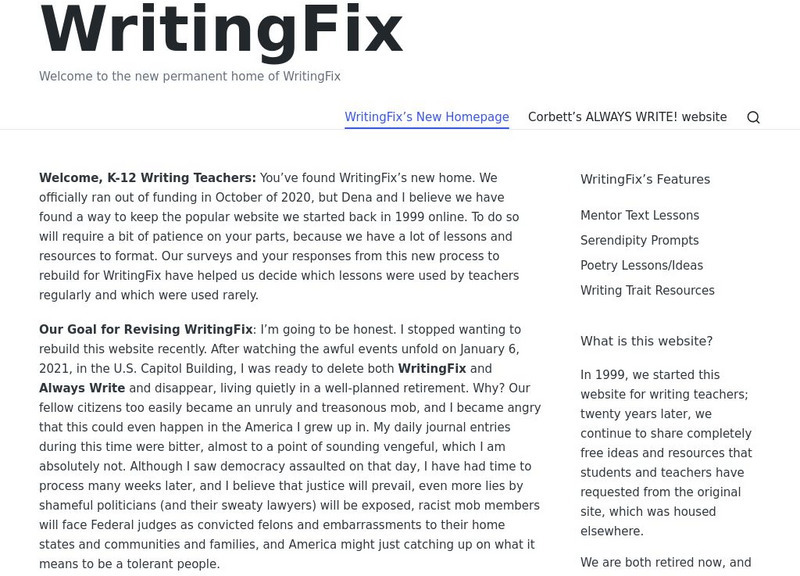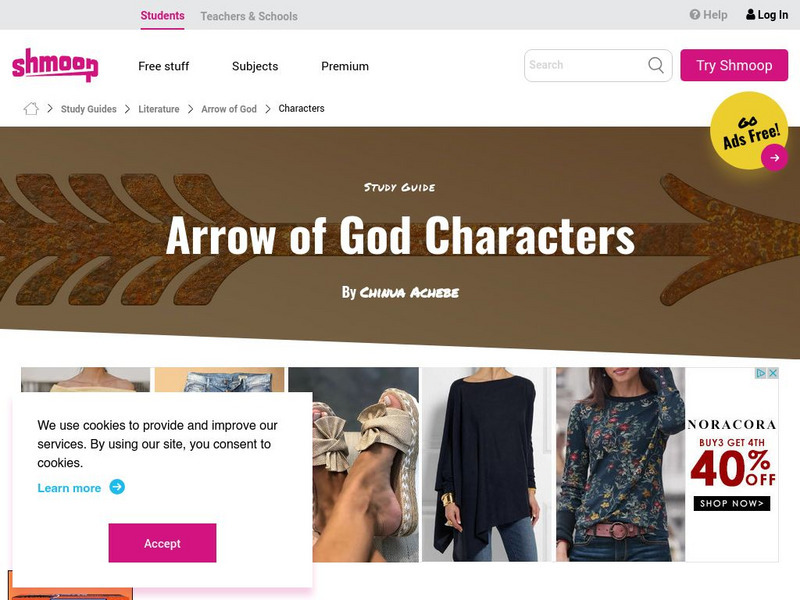Hi, what do you want to do?
TES Global
Tes: Scheme of Work: The Tempest by William Shakespeare
[Free Registration/Login Required] During these multi-day lessons, students will closely read William Shakespeare's work, The Tempest. Students will analyze characters, plot, and themes. Students will culminate their understanding...
Annenberg Foundation
Annenberg Learner: Interactives: Elements of a Story
Explore the elements of a story using the well-known Cinderella story as source material. Learn about setting, character, sequence, exposition, conflict, climax, and resolution.
Other
Cummings Study Guides: Much Ado About Nothing, a Study Guide
This is a study guide for William Shakespeare's Comedy Much Ado about Nothing.
Annenberg Foundation
Annenberg Learner: Elements of a Story Interactive
Explore different ingredients, or elements, that go into stories and make them so much fun. Read the story, "Cinderella," and look at all the different pieces of the tale to see how they all fit together.
BBC
Bbc Bitesize: Higher English
This site provides information about characters, plot, and setting of several different pieces of literature. It offers links to activities and tests on topic such as analysis and evaluation, creation and production, drama, novels, and...
Florida Center for Reading Research
Florida Center for Reading Research: Narrative Text Structure: Retell Wheel
A lesson plan in which students read a narrative text and then turn a question wheel to answer questions about the characters, setting, conflict, and plot. Materials are included.[PDF]
Louisiana Department of Education
Louisiana Doe: Louisiana Believes: English Language Arts: Grade 7: A Christmas Carol
Seventh graders learn that writers use stories and distinctive characters to teach us lessons. Students will explore how the choices of characters affect the plot and build the theme of a story. Students will come to understand that...
University of Massachusetts
University of Massachusetts: Aesop's Fables: "The Fox and the Grapes"
Two traditional retellings of Aesop's fable "The Fox and the Grapes." The first has literal illustrations of the original fable. The second tells the same story, but has illustrations that give the story a modern setting and characters...
Shmoop University
Shmoop: All the King's Men
Winner of the Pulitzer Prize for fiction in 1947, this remarkable novel is analysed in terms of plot, characters, themes and quotations in this very detailed site. An excellent set of study questions is included.
Shmoop University
Shmoop: An Ideal Husband
This still current play, An Ideal Husband , is still relevant today. Read about the fascinating plot, setting and characters in this comprehensive site.
Shmoop University
Shmoop: A Tale of Two Cities
Although it was writtenin 1859, A Tale of Two Cities still has things to tell us today. Read about the plot, characters, setting and themes in this fascinating and informative site about the novel.
Caro Clarke
Not Stopping the Reader: How to Avoid Stumbling Blocks
This is the eighth article in a series that focuses on helping the new novel author. This article looks at how the author can avoid creating stumbling blocks that disrupt the flow of the novel.
Quizlet
Quizlet: R.3 Analyze How and Why Individuals, Events, or Ideas, Develop/interact
Please align to CCSS.ELA-Literacy.CCRA.R.3 Analyze how and why individuals, events, and ideas develop and interact over the course of a text.
AdLit
Ad lit.org: Classroom Strategies: Story Maps
Story Maps are used for teaching students to work with story structure for better comprehension. This technique uses visual representations to help students organize important elements of a story. Students learn to summarize the main...
Teachnology
Teachnology: Lesson Plan: Twenty Questions
In this activity each student will have a turn in the "hot seat" where they answer class questions about a book they are reading including questions about the characters, setting, and plot.
TES Global
Blendspace: Interpreting Literature Terms
A fourteen-part learning module on literary terms including links to text, videos, word lists and images on literary terms such as plot, setting, character, point of view, style, theme, and more.
Quizlet
Quizlet: Story Elements Quiz 6th Grade Honors: Learn
This interactive lesson engages students in learning story element definitions. Students will type the correct story element after reading its definition.
ClassFlow
Class Flow: Story Elements
[Free Registration/Login Required] This flipchart contains story elements to be used with the novel, The Watson's go to Birmingham. It is possible to change the flipchart to fit any novel being read at that time.
Bibliomania
Bibliomania: Thomas Hardy: The Mayor of Casterbridge
Read Thomas Hardy's novel, "The Mayor of Casterbridge." The book's 45 chapters are preceded by information on its setting, characters, and plot.
Writing Fix
Writing Fix: Writing Fix Homepage
Have you ever needed someone to help you out with your writing? This site offers help to young scholars and teachers. The lessons and resources are organized based on the 6 Writing Traits model. An especially interesting feature of the...
State University of New York
Oneonta: Reading "The Pioneers" as History
This detailed site provides a guide for reading "The Pioneers" by James Fenimore Cooper. Includes background information about the book, a description of the setting and form, a list and description of principal characters, and...
Teachers.net
Teachers.net: The Gingerbread Man
Introduce your primary students to retelling and sequencing skills. Will also help move your students to higher-level thinking which deals with characters, setting, and plot. Site offers one week's worth of lessons.
Shmoop University
Shmoop: Arrow of God
Set in Nigeria during the 1920s the novel Arrow of God is analysed in depth in this fascinating site. Read about the characters, plot, and themes.
Writing Fix
Writing Fix: A Chapter Book Writing Lesson: Creating a Parallel World
Inspired by the opening events in The Subtle Knife by Philip Pullman, young scholars are asked to create an original parallel world that is similar to ours but different in certain ways. They will focus on the similarities and...























